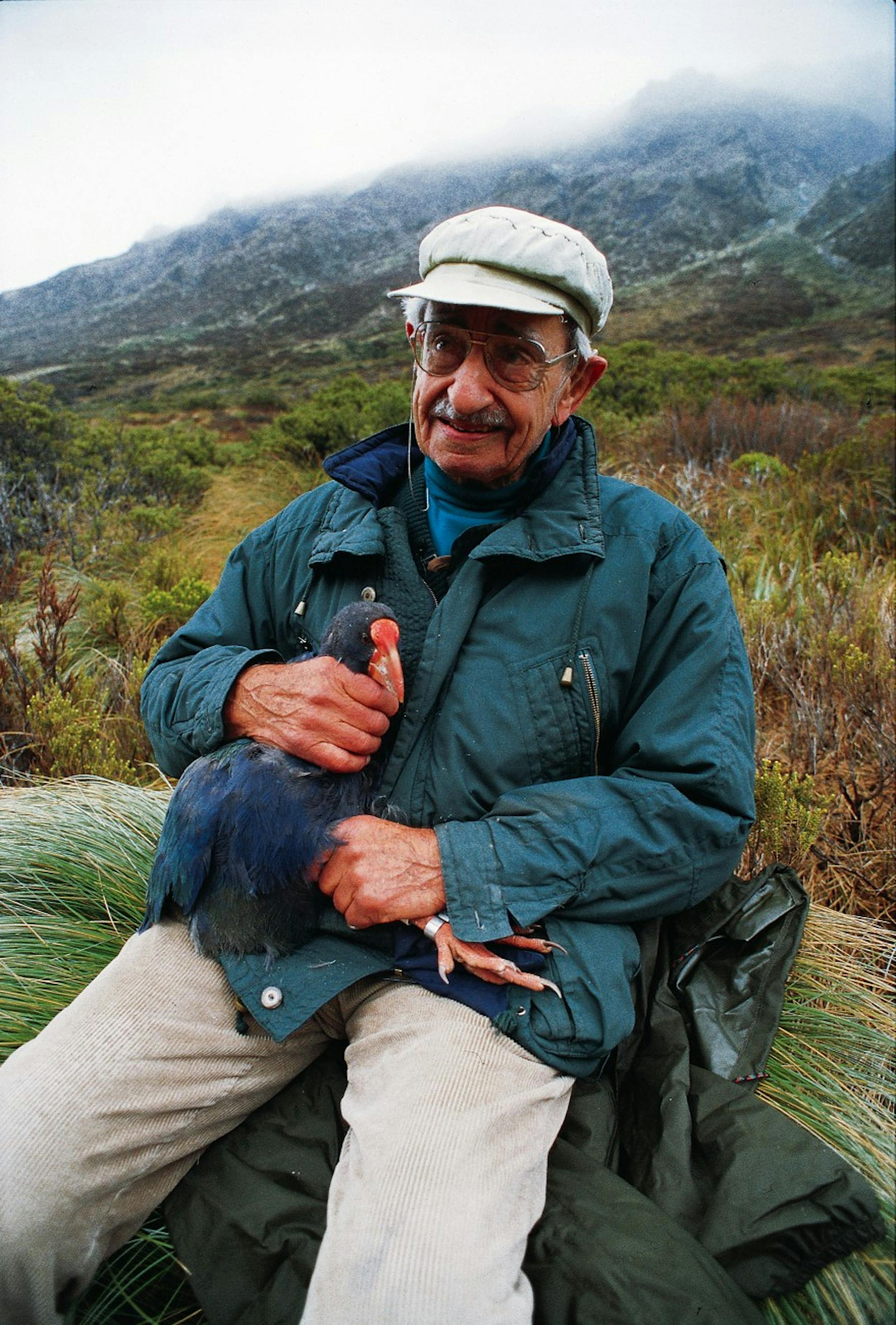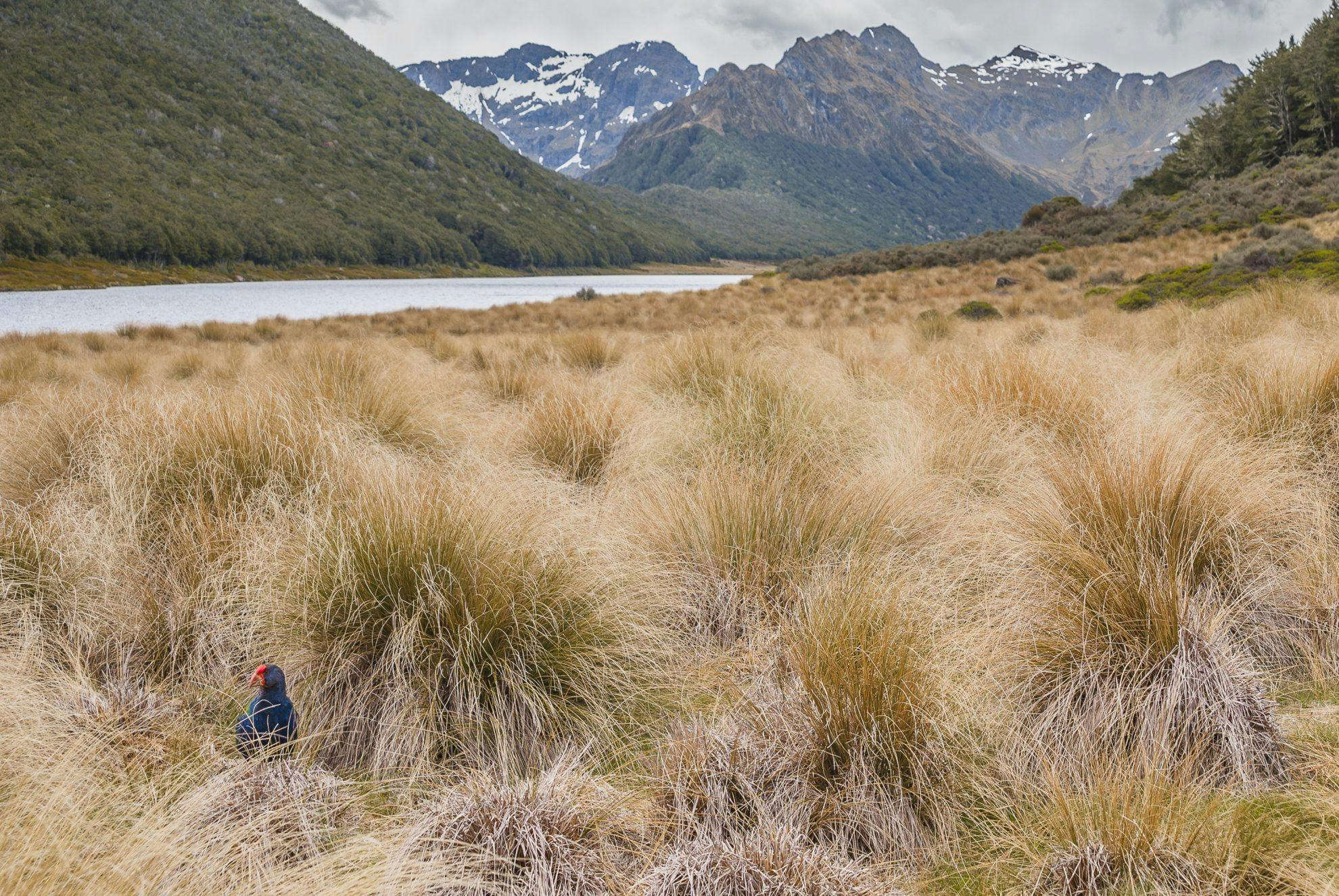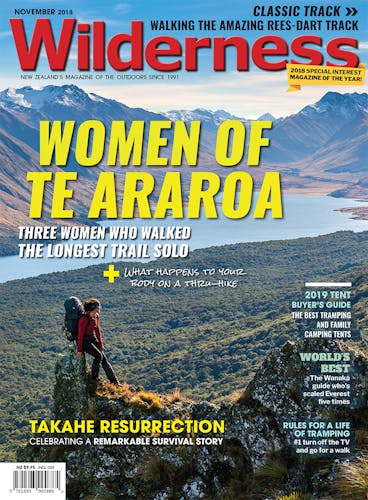In 1948, when Dr Geoffrey Orbell rediscovered the takehē in the Murchison Mountains, it made world news. Seventy years on, the future of the bird once teetering on the brink of extinction is much brighter
First, we just heard rustling in the bushes. Then a loud call. We stopped and listened. Suddenly, poking from the tussock was a bright red beak, and then quietly, gracefully a large blue-green bird stepped, knees high, out onto the track.
Being able to see a takahē – the bird that ‘came back from extinction’ – on the Heaphy Track in September was a highlight of the trip. It was also something that by rights should not have happened.
Takahē (Notornis mantelli) were once widespread in the South Island, but after the arrival of mammalian predators, their numbers declined rapidly to the point where, by the end of the 19th century, the species was considered extinct. A flightless grazer, it is similar to its more prolific cousin the pukeko, but of a more solid stature, with stronger legs and brighter plumage.
In the 1940s, red deer were spreading out of control and causing severe damage to native vegetation, including snow tussock, the main food of the takahē. The deer culling days followed. For 12 years, during the red deer plague in Fiordland, Invercargill doctor Geoffrey Orbell was a government hunter.
In April 1948, Orbell set out on a hunting trip into the Murchison Mountains with Neil McCrostie and Rex Watson. In his journal, Orbell describes how they found a valley with very steep sides and a lake at the bottom. At the lake, which would later bear his name, Orbell shot a stag and heard a call of a bird he could not identify. On the sandy lakeshore, he saw a trail of unusual bird footprints. But there was no time to investigate, as the men had to get back to their boat before dark.
It wasn’t until November 20 that year that Orbell returned to the lake accompanied by his two friends and Watson’s girlfriend Joan Telfer, equipped with a camera and 27m of rabbit net. ‘We returned to where we had found the tracks on our last trip,’ he wrote in his journal. ‘Suddenly … I spotted a bright blue-green bird in a little clearing in the snowgrass.’ Just 20m away stood a takahē.
The news of the takahē rediscovery stirred up the ornithological world and became an overnight sensation. Orbell and his three companions were courted by news media from around the globe.
Since then, there’s been an effort to save the takahē from extinction. To protect the birds, the Murchison Mountains were declared a special area in 1949 and closed to the public. But the wild population of the takahē living there was shrinking. By the mid-1970s, deer were finally brought under control, but tussock can take up to 20 years to recover from heavy browsing and without food the takahē population began to collapse. By the early 1980s, there were just over 100 left.
Drastic action was required.
Dave Crouchley was Takahē Recovery group leader and a programme manager at the NZ Wildlife Service (predecessor to the Department of Conservation) in 1985 when a decision was made to hand-rear the takahē. He was involved in setting up the Burwood Takahē Breeding Centre at the Gorge Hill red tussock reserve between Te Anau and Mossburn. It was a purpose-built facility, where eggs taken from wild takahē nests were artificially incubated and young chicks were fed using hand puppets resembling an adult bird.

Alongside the breeding programme, DOC took steps to protect the birds living in the wild, using pest control and relocating birds to predator-free islands.
According to Crouchley, takahē’s natural propensity to disperse widely worked to the birds’ own detriment. “In a dispersed community it’s hard to find a mate, and it made it difficult to set up new sites for the takahē,” he says.
It’s been a steep learning curve hampered by setbacks. The attempt to establish a new wild site in the Stuart Mountains in the late 1980s failed. Almost all of the 52 birds released there vanished or were killed by predators and a series of unusually heavy winters in the early 1990s.
During a stoat plague in 2007, the Murchison Mountain population shrank from 168 to 93 in a matter of months. In 2015, four takahē were accidentally shot on Motutapu Island by hunters culling pukeko.
But more recent years have seen a turn-around. DOC senior biodiversity ranger Glen Greaves has been working on the Takahē Recovery programme for 12 years.
“The takahē survival rate at Burwood was higher than in the wild, but puppet rearing was incredibly intensive and therefore very expensive,” he says. “In addition, puppet reared birds were not as good at parenting as wild birds.”
In 2011, DOC ceased the practice and moved to a hands-off approach relying on supplementary feeding, nest management and genetics to maximise takahē productivity and survival of the chicks.
The Burwood unit has 19 one-hectare pens – one per breeding pair – and a 150ha open enclosure housing a further five pairs. The tussock reserve provides similar conditions to the home of wild takahē in Fiordland.
Supplementary feeding occurs twice. Every Monday and Thursday, ranger Sam Haultain walks the enclosures with a bin full of ‘takahē cereal’ on her back and a smaller container with food which she shakes to encourage the birds out of the tussock.
One of Haultain’s jobs at Burwood is shifting and pairing birds, which she likens to playing chess.
“You’re trying to work out genetic information, ages, sizes and who is breeding,” she says.
Two years ago, there were 250 takahē. Now we have 350 birds and we expect to have 500 within five years.
In the wild, takahē breed once a year laying two eggs (20 per cent of them infertile), but usually only manage to rear one chick. DOC removes infertile eggs and moves eggs between nests for a better breeding outcome.
The programme became so successful that Burwood was running out of space.
“We now we have 104 birds with Burwood producing about 25 chicks each year,” Greaves says. “We had to build more sanctuaries [around New Zealand] to house them all. We used to have all eggs in one basket. Now we have diversified.
“Two years ago, there were 250 takahē. Now we have 350 birds and we expect to have 500 within five years.”
The predator control programme has also intensified. Across the 50,000ha of the Murchison Mountains reserved for takahē, DOC manages 2500 traps which are checked at least four times a year.
Until last year, the Murchison Mountains were the only wild takahē site, with 130 birds. DOC spent years searching for other sites where a wild population could be established. To qualify, the site needed to be in the South Island where takahē occurred naturally, it had to be large enough to support a population of at least 30 breeding pairs, it needed native grass cover, low predator density and better climate and geography than Fiordland.
Gouland Downs on the Heaphy Track was perfect and earlier this year 30 takahē were released there.
Monthly monitoring shows that so far the birds appear quite settled. They are feeding on a wide range of plants and keep in good health. The real test will come this spring when successful breeding and raising of chicks would confirm the site’s suitability for takahē and whether further birds could be released into the area.
Last year, takahē moved two steps away from extinction – from nationally critical to nationally vulnerable in the New Zealand Threat Classification System. My sighting of the takahē on the Heaphy Track suggests that one day spotting takahē in the wild will be a reality for many more people.








